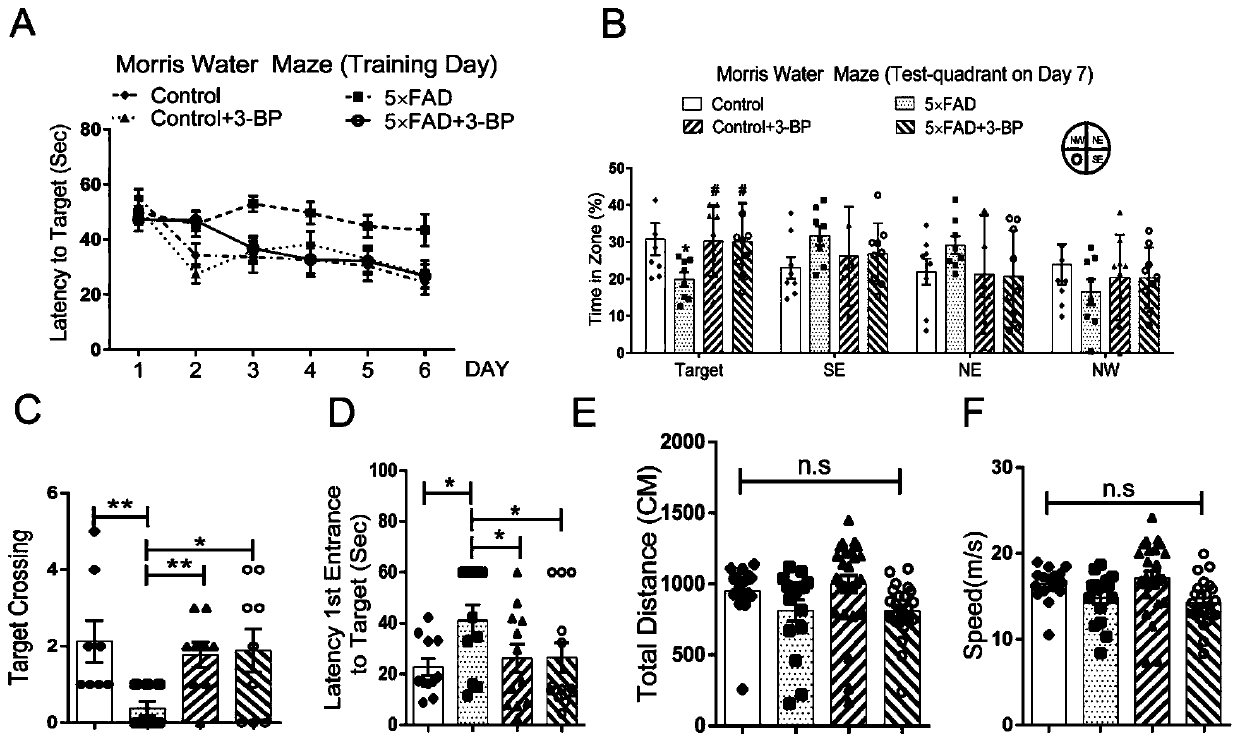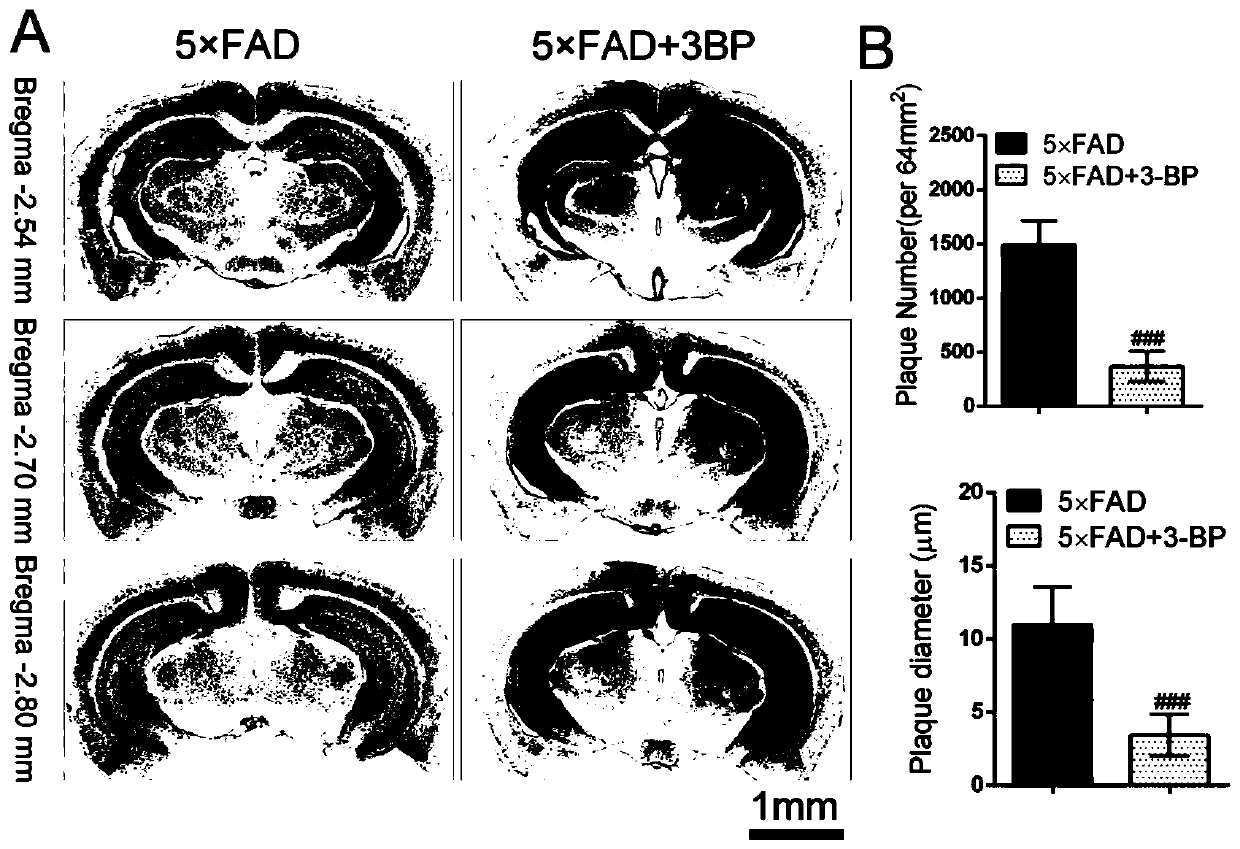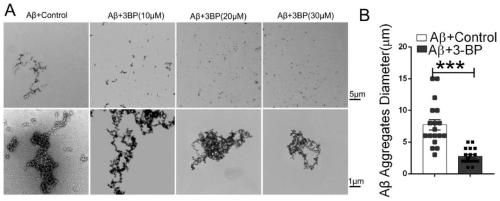Application of hexokinase inhibitor to preparation of medicine for preventing and/or treating Alzheimer disease
A technology of Alzheimer's disease and hexokinase, which is applied in the field of preparation of drugs for the prevention and/or treatment of Alzheimer's disease and hexokinase inhibitors, and can solve problems such as the lack of content of lonidamine
- Summary
- Abstract
- Description
- Claims
- Application Information
AI Technical Summary
Problems solved by technology
Method used
Image
Examples
Embodiment 1
[0046] Embodiment 1: 3-BP improves the cognitive ability of Alzheimer's disease model mice
[0047] (1) Background and grouping of experimental mice
[0048] 5×FAD transgenic mice are classic AD transgenic mice, 5×FAD transgenic mice overexpress mutations in two humanized and familial Alzheimer’s disease-associated genes APP and PS1, the expression of these two genes is controlled by Initiated by the mouse prion protein promoter. The PS1-dE9 mutation of the human presenilin gene is caused by the deletion of the ninth exon of the gene, which can lead to early-onset Alzheimer's disease. Control mice were derived from littermates of wild-type mice. Nine-month-old 5×FAD mice and control mice were used in the experiment.
[0049] The experimental groups were divided into four groups: wild type mice were given control reagent group (WT), 5×FAD mice were given control reagent group (5xFAD), wild mice were given 3-BP group (WT+3-BP), 5×FAD mice were given 3-BP group (WT+3-BP), 5× ...
Embodiment 2
[0054] Example 2: Immunohistochemistry and immunofluorescence staining to detect the scavenging effect of 3-BP on Aβ in the brain of Alzheimer's disease model mice
[0055] (1) Stereotaxic intracerebroventricular injection of mouse brain
[0056] 5×FAD mice were intraperitoneally injected with 5% chloral hydrate (0.1mL / 15g). After complete anesthesia, the head hair was shaved and fixed on a brain stereotaxic instrument. Disinfect with povidone iodine, cut the scalp, find the bregma and bregma under the microscope for leveling and positioning, drill a small hole (x±1.0mm, y-0.4mm) at the ventricle with a 0.5mm drill bit, and remove bone debris , slowly insert the microsyringe into the lateral ventricle, descend to the appropriate depth coordinate (z2.2mm) and inject (3-BP, 2.5μL, 0.5mg / kg). After the injection, stop the needle for ten minutes, withdraw the needle slowly, and suture the skin of the mouse head.
[0057] (2) Tissue fixed section
[0058] After one week of intra...
Embodiment 3
[0062] Example 3: Observation of the Effect of 3-BP on the Aβ Aggregation State in Vitro by Electron Microscopy
[0063] Prepare Aβ1-42 as follows: Dilute the polypeptide dissolved in DMSO (5 mM) to 100 μM with phenol-free cold F-12 cell culture medium (Gibco), sonicate for 10 min to make freshly used oligomeric Aβ1-42 . Some peptides were cultured at 22°C and 220rpm for 72 hours to age them in vitro, and different concentrations of 3-BP were added during this process. Afterwards, culture at 4°C for 24 hours, and centrifuge at 16,000×g for 15 minutes. The collected supernatant contains Aβ1-42 aggregates, which are observed and analyzed by transmission electron microscope. Depend on image 3 It can be seen that when 3-BP is added, the aggregation state of Aβ becomes loose and the volume of multimer becomes smaller with the increase of the concentration of 3-BP added. This experiment shows that 3-BP can reduce Aβ aggregation and form smaller aggregates, which facilitates the ...
PUM
| Property | Measurement | Unit |
|---|---|---|
| Diameter | aaaaa | aaaaa |
| Thickness | aaaaa | aaaaa |
Abstract
Description
Claims
Application Information
 Login to View More
Login to View More - R&D
- Intellectual Property
- Life Sciences
- Materials
- Tech Scout
- Unparalleled Data Quality
- Higher Quality Content
- 60% Fewer Hallucinations
Browse by: Latest US Patents, China's latest patents, Technical Efficacy Thesaurus, Application Domain, Technology Topic, Popular Technical Reports.
© 2025 PatSnap. All rights reserved.Legal|Privacy policy|Modern Slavery Act Transparency Statement|Sitemap|About US| Contact US: help@patsnap.com



